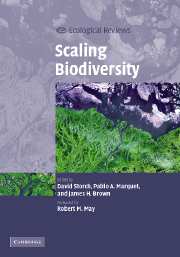Book contents
- Frontmatter
- Contents
- List of contributors
- Foreword by Robert M. May (Lord May of Oxford)
- Preface
- 1 Introduction: scaling biodiversity – what is the problem?
- PART I Spatial scaling of species richness and distribution
- PART II Alternative measures of biodiversity: taxonomy, phylogeny, and turnover
- PART III Scaling of biological diversity with energy and the latitudinal biodiversity gradient
- PART IV Processes, perspectives, and syntheses
- 16 Spatiotemporal scaling of species richness: patterns, processes, and implications
- 17 Scaling biodiversity under neutrality
- 18 General patterns in plant invasions: a family of quasi-neutral models
- 19 Extinction and population scaling
- 20 Survival of species in patchy landscapes: percolation in space and time
- 21 Biodiversity power laws
- Index
- Plate section
- References
17 - Scaling biodiversity under neutrality
Published online by Cambridge University Press: 05 August 2012
- Frontmatter
- Contents
- List of contributors
- Foreword by Robert M. May (Lord May of Oxford)
- Preface
- 1 Introduction: scaling biodiversity – what is the problem?
- PART I Spatial scaling of species richness and distribution
- PART II Alternative measures of biodiversity: taxonomy, phylogeny, and turnover
- PART III Scaling of biological diversity with energy and the latitudinal biodiversity gradient
- PART IV Processes, perspectives, and syntheses
- 16 Spatiotemporal scaling of species richness: patterns, processes, and implications
- 17 Scaling biodiversity under neutrality
- 18 General patterns in plant invasions: a family of quasi-neutral models
- 19 Extinction and population scaling
- 20 Survival of species in patchy landscapes: percolation in space and time
- 21 Biodiversity power laws
- Index
- Plate section
- References
Summary
Introduction
To better understand biodiversity scaling, it may be useful to characterize the biodiversity scaling relationships that arise from the neutral perspective. This exercise will help in formulating quantitative null hypotheses for observed biodiversity scaling relationships. Here we use the term biodiversity to refer not only to species richness, but also to relative species abundance, and biodiversity scaling to refer to how patterns of biodiversity change on increasing sampling (spatial) scales. The study of biodiversity includes questions about the spatial dispersion and geographic range of species, relative species abundance, endemism, and beta diversity, the turnover of species across landscapes. A full discussion of all-taxa biodiversity scaling in the context of neutral theory is beyond the scope of the present theory because the theory currently applies only to communities of trophically similar species (a tree community, for example). It is also individual based rather than biomass based. Despite these limitations neutral theory is nevertheless a mechanistic, dynamical theory of community assembly based on fundamental demographic processes (birth, death, dispersal, speciation) – even though its postulated assembly rules are extremely simple. Under current neutral theory, speciation, ecological drift (demographic stochasticity in birth and deaths), and dispersal govern the presence or absence and the abundance of species in communities over local to global scales. Extinction is also critically important, but under neutrality, the extinction rate can be predicted once the other three processes are known.
- Type
- Chapter
- Information
- Scaling Biodiversity , pp. 347 - 375Publisher: Cambridge University PressPrint publication year: 2007
References
- 19
- Cited by



